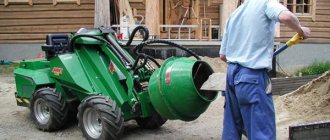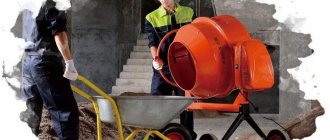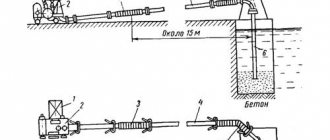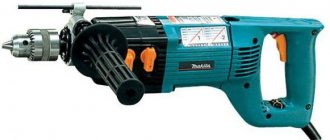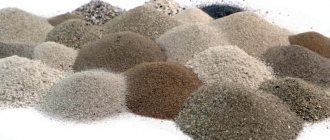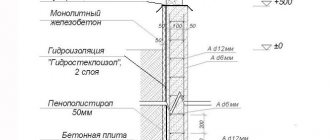DIY concrete mixer: design and manufacture
A concrete mixer in a suburban area, and even more so in rural areas, is a necessary device, the need for which arises infrequently.
Diagram of the construction of an electric concrete mixer.
Therefore, many craftsmen prefer to make the much-needed design themselves. A DIY concrete mixer is not at all as complicated a device as it might seem when looking at an expensive factory model.
Design features of the concrete mixer
Today there are many homemade models. How to design a concrete mixer that is simple and has inexpensive parts, some of which you may already have, is described below.
- frame;
- bracket and hook;
- gearbox;
- engine drive gear;
- electric motor;
- capacity;
- handles for turning the structure over;
- bracket;
- axis.
Image 1. Diagram of a manual concrete mixer.
For manufacturing you will need the appropriate parts, some of which are easy to find. It’s good if you have a welding machine, but even if you don’t have one, the necessary connections can be made using bolts and nuts. What else do you need?
- The frame is from an old iron bed (Soviet-made). It will serve as the basis for the entire structure.
- Suitable container. You can use an iron or plastic barrel with a capacity of 200 liters. Another option is to use a cut-off part of a used gas cylinder. Some people prefer to tinker and use a metal barrel to make a structure that resembles a factory product (IMAGE 1).
- Engine. A unit of any type (synchronous or asynchronous) with an approximate power of 1.5-2.5 kW and a rotation speed of 1500 rpm is suitable.
- A gear mounted on the motor shaft.
- Gearbox for transmitting and reducing torque from the electric motor to the tank. As this device, you can use a gearbox from escalator lines. It should produce 25-30 rpm at the final stage.
- Wheels. They fit well on a transformer welding machine - the “wheels” are specially designed for heavy loads.
Return to contents
Manufacturing process
- First, the supporting frame is welded or fastened with nuts and bolts, for the manufacture of which you need metal corners from an old bed (they can be purchased if necessary).
- An axle is welded to the finished frame, on which the wheels need to be secured (it is better to use bearings). An axis with a pair of brackets is fixed across the frame. The concrete mixer container is attached to the upper gear pulley. The engine must be well secured to a thick metal plate (3.5-5 mm) with 4 bolts and nuts (so that it can be easily removed if necessary).
- Now you need to weld a reinforcing bar (8 mm) to the bottom, having previously bent a hook at its end. It will fit freely into the hole - after mixing the solution, just pull the fitting towards you and you can pour the contents into the right place. Finally, attach a handle to the tank - it will be more convenient to work.
Return to contents
Other design options
To transfer rotation from the engine to the barrel and at the same time reduce the speed, you can use simpler options for manufacturing gearboxes. It uses a rim from an old bicycle wheel, put on a shaft with bearings, a gear and a toothed belt.
If you don’t have the desire, opportunity or experience to tinker with an electric motor, then you can build a simple concrete mixer with your own hands. You will have to turn it yourself, but you will get complete independence from electricity and will not have to make, look for a gearbox, or buy an electric motor.
Drawing of a manual concrete mixer.
Making a manual unit is not difficult; the parts for its creation can certainly be found. And anyone can work with such “technique”. The manufacturing algorithm is as follows:
- Take a metal barrel (200 l) with a lid and bottom. You need to attach flanges with bearings to them (you can take them from any equipment, not necessarily new).
- A door is cut out on the side of the barrel, which should be closed using a simple lock and hinges.
- The crucial moment is to find and secure the shaft of the required diameter. The shaft must fit into the flanges with bearings with the necessary force. At one end of the shaft you need to bend the handle, onto which it is best to put a hollow cylinder so as not to get calluses on the palm.
- At the final stage, the structure is dug into the ground at a 30-degree angle.
Many craftsmen use motorcycle and moped engines as the “driving force”. But in this case you need to have technical knowledge. Sometimes wood, rather than metal, is often used as the basis of the structure. This is justified if the mortar mixer is rarely used. To make the frame you will need very few parts.
- Wooden block 10x10 or 15x15 cm in cross section. This thickness will provide the required strength of the unit.
- Wood glue.
- Self-tapping screws for wood.
It is best to make connections “into a tenon”, to a depth of half the timber. The joints are coated with glue, then additionally reinforced with self-tapping screws. This installation is most appropriate to use if the drive is manual, without an electric motor.
Return to contents
The nuances of making a concrete mixer yourself
A do-it-yourself electric concrete mixer is a unit that will work more reliably if you use a ready-made gearbox assembled with an engine of the appropriate power.
You just need to remember: the speed at the output of the gearbox is within 25-40 rpm. The electrical cable must be of appropriate power. The same requirement applies to the plug and socket.
1landscapedesign.ru
Mortar mixers and their classification
Scheme of a mortar mixer.
The mortar mixer is a simple unit that is easy to use and can be used in private construction.
The main difference between a mortar mixer and a concrete mixer is the material with which these devices work. Concrete mixers work with materials that contain fractions of solid filler measuring 20-70 mm. The mortar mixer is designed to work with fillers with smaller fractions. The volume of the mortar mixer drum varies, its volume varies from 30 to 1200 liters.
Mortar mixers, like concrete mixers, come in two types:
- Forced mixing.
- Gravitational.
In mortar mixers, the components are most often mixed forcibly; a rotating horizontal shaft is used for this with a stationary drum. Small-volume mortar mixers do not have dispensers; they are installed on mortar mixers with a volume of 100 liters or more. Thus, it is necessary to measure the amount of water added to the solution “by eye”.
If we take for consideration a mortar mixer of medium volume, 250 liters, then we can distinguish the following components:
- Electric motor or internal combustion engine.
- Drive unit.
- Blade shaft.
- Trough-shaped mixing drum.
Scheme of a gravity mortar mixer.
From mortar mixers with a volume of 30 to 65 liters, the solution is removed by tilting the drum. If the drum has a large displacement, then most often such devices have a hatch for dumping the mixture.
Just like concrete mixers, mortar mixers come in industrial and private sizes. Materials are discharged into industrial-scale mortar mixers using a specialized mechanized device.
Which concrete mixer to choose: crown or gear mixer
Geared concrete mixer
When building a private house or concreting a local area, you cannot do without this type of construction equipment such as a concrete mixer. Which concrete mixer is better: a crown or a gear mixer – this article will help you figure it out.
Modern manufacturers offer many models that differ in their parameters and operating principles.
These units can be amateur, for independent private construction, or industrial. The most common are crown and gear models for private use. To understand which model is better, you need to compare their parameters.
The content of the article
Types of concrete mixers
Mixing units are divided into two categories according to the principle of operation - gravitational (rotary) and forced.
Gravitational type of action
This type of equipment is used for private construction and other household uses. It is a barrel-shaped container with internal blades. The tank rotates around its axis, with a possible change in the position of the container in the horizontal plane.
While mixing the solution, it sticks to the walls of the tank and then, under the influence of gravitational forces, falls. The rotation speed increases when the barrel is tilted. Such a concrete mixer mixes both cement and concrete, or other mortar with coarse filler, with equal quality.
Concrete mixer with gravity principle of operation
Forced action type
This equipment is based on a stationary drum equipped with rotating blades. Such units are convenient for mixing solutions with various fillers.
The finished mixture is unloaded through a window located on the side of the drum. This installation is equipped with a powerful motor, so it consumes a large amount of electricity. Belongs to the class of professional equipment.
Forced type concrete mixer
Advantages of concrete mixers depending on the drive mechanism
Depending on the type of drive device, concrete mixers are divided into crown and gear mixers. Gear-type devices are considered more reliable, but if they break down, repairs will be too expensive. It will be more cost-effective to purchase a new unit.
Therefore, for home use, experts advise purchasing crown-type gravity devices, since if the crown breaks, repairs can be done with your own hands. This part can be replaced in a few hours, and its price is not too high.
To make a choice which concrete mixer is better: gear or crown mixer, you need to compare their characteristics.
Geared
This type of concrete mixer is characterized by the following features:
- The location of the gearbox under the drum prevents substances such as sand, small stones, dust and other abrasives from entering it. This design feature significantly extends the operating life of the unit;
- this type of equipment is available with different volumes of mixing tank, which allows you to choose a model for private household use or for large construction work;
- The rotating device is mounted on the gear shaft;
- the number of transmission links in the design of this type of device is reduced to a minimum, so an optimal balance of power and electricity consumption is achieved;
- tanks of the same volume in the crown and geared models may have different usable capacities - in the geared model it is larger;
- Before deciding which is better, a crown or gear concrete mixer, it is important to evaluate the positive qualities of the latter in the form of efficiency, safety and quiet operation.
One of the significant disadvantages can be noted - in the event of a breakdown of one part of the transmission of this type of equipment, the entire unit will be replaced, and this is quite an expensive pleasure.
Geared concrete mixer
Ventsovaya
These devices have the following characteristics:
- this type of device is convenient for any concrete work, as it is equipped with a convenient device for unloading the working solution;
- when choosing which concrete mixer, a crown or gear type, is economically profitable, it is worth noting that crown models are characterized by high maintainability - you can replace a broken or worn part without replacing the entire assembly;
- These are durable and compact mobile devices equipped with wheels and a reinforced frame;
- mixing of the solution in the drum occurs due to its movement, which is ensured by the presence of a crown. A concrete mixer with a plastic crown will have a lower cost than one with a cast iron product. However, a crown made of cast iron or steel will last longer.
Crown concrete mixer
It turns out that gravity-driven crown units are in greater demand among consumers than gear units. And this is primarily due to their high maintainability.
The photo shows a concrete mixer. Instructions that tell you about the rules for choosing such a model will be given below.
Crown concrete mixer
Video material
How to choose the right concrete mixer
How to choose a concrete mixer
When choosing a concrete mixer with a girdle drive, you need to pay attention to several main points - the material and strength of the frame, the characteristics of the container and the engine.
Design of a crown type concrete mixer
Barrel volume
This is the most important indicator when choosing a concrete mixer that you should pay attention to. Modern manufacturers offer devices with a wide range of mixing tank capacities - from 30 liters. up to 300 l.
For private use, you can settle on the golden mean. Particularly popular are devices with a tank volume of 130 - 160 liters. They are characterized by high productivity with a low weight of the device, and allow you to carry out both large and minor concrete work.
Note! When choosing the volume of a container, it is important to take into account that the output will be a smaller volume compared to the declared one. This is due to the design feature of the concrete mixer, in which the tank is in an inclined position, which does not allow its volume to be used at 100%. The denser the kneading is needed, the greater the angle of inclination of the container. Average calculations boil down to the fact that a concrete mixer of this type in one batch will produce thick concrete with a volume of 50% of the total, and plastic concrete will produce 65%.
The thickness of the barrel walls plays an important role. If strength is a priority, then you need to take a model with thicker walls, but keep in mind that it will have significant weight. If an important quality is the ability to move the unit around a construction site, then a thin-walled model will be lighter and more maneuverable.
Dependence of the finished solution on the volume of the drum
Concrete mixer tank
Engine power
Depending on the duration of the continuous cycle during which the unit will operate and the load on it, the choice of model of a particular power depends. For example, if you need to prepare the mixture for 6 hours continuously, you will need a model with a power of 1 kW. For private use, a concrete mixer with a power of 800 W is sufficient.
The choice of power is also influenced by the nature of the load, which depends on the volume of the solution being mixed - it should not exceed the calculated working volume of the device. In case of overload, engine and transmission damage may occur.
The table below shows the ratio of power, volume, weight and dimensions of the concrete mixer.
| Capacity volume | Motor power | Length, mm | Width, mm | Height, mm | Weight, kg |
| 200 | 1,1 | 1200 | 1050 | 1400 | 140 |
| 250 | 0,75 | 1620 | 1070 | 1500 | 200 |
| 300 | 1,1 | 1620 | 1070 | 1500 | 220 |
| 350 | 1,1 | 1620 | 1070 | 1500 | 240 |
| 500 | 2,2 | 1270 | 1650 | 1730 | 360 |
Engine of a concrete mixer
Gear material
Metal must be used as the material for manufacturing. It may be cast iron, but steel is much more practical, since it is not inferior to cast iron in strength, and has less weight.
It is important to pay attention to the thickness and strength of the shaft to which the drive gear is attached. In this case, a slight backlash is allowed.
Metal gear
Crown material
Structurally, the crown is a part with teeth surrounding the kneading container, to which the belt clings. The most common materials for their manufacture are cast iron and plastic. Modern polymers are not inferior in strength and durability to steel or cast iron products.
A concrete mixer with a plastic crown is much cheaper and does not burden the unit due to its low weight. The polymer material affects the noise level during operation of the concrete mixer - with a plastic part it is much quieter.
Cast iron crown
Rotating device
The operation of a concrete mixer is associated with periodic mechanical changes in the position of the container. It will be more convenient to switch the container position mode if the rotating mechanism is made in the form of a wheel.
Options for rotating device in the form of a lever and a wheel
The video in this article will help you evaluate the advantages and disadvantages of crown and gear concrete mixers in order to decide on the choice of the required model.
beton-house.com
Concrete mixer and its qualities
In order to understand the difference between the two devices, you first need to understand what each of them is.
Not a single large construction site is complete without a concrete mixer. Two types of concrete mixers are used: gravity concrete mixer and forced concrete mixer.
The basis for a gravity concrete mixer is a drum with blades. The drum rotates continuously, allowing the necessary ingredients to mix properly, and the resulting mass not to harden.
Forced-action concrete mixers are also equipped with blades, but the main difference is that it is not the drum that rotates, but the blades. Thus, the device acts on the mixture not with the help of gravity, but with the help of blades, that is, forcibly, hence the name.
Scheme of work
Speaking about the design of a gravity-type concrete mixer, it is necessary to highlight a number of parts, such as: chassis, welded frame, crossbeam, clamp, drum, rotating mechanism, electrical equipment. These parts are an integral part of a gravity-type concrete mixer. In some cases, a gear rim is attached to the drum mixer, and to make it easier to transport, the tubular drawbar is removable. To increase the stability of the unit, additional support tubes are added.
The operating procedure of the concrete mixer is as follows:
- The serviceability of the design is checked.
- The test is carried out in a practical way: an empty drum is started.
- The structure is brought into working condition.
- Water is poured in, then cement, sand and other necessary materials are added.
- After mixing, the structure tilts, allowing the mixture to fall freely into the required container.
Forced-action concrete mixers are distinguished by the fact that they have internal and external blades, as well as scrapers. The mixture is loaded into the drum in various ways, depending on the size of the apparatus. If the dimensions are relatively small, then loading of materials is carried out manually. If the design is designed to work on an industrial scale, then the loading of materials is carried out using a mechanical unit. After completing the mixing of materials, the composition is thrown into the provided hatch, which is located at the bottom of the drum.
Concrete mixers come in manual, gasoline and electric motor types. One of the few disadvantages of concrete mixers with an electric motor is that when it is disconnected from the network for a certain period of time, the materials in the drum are released and the hatch opens.
manufacturing instructions and drawing
Concrete mixers are not a constantly used type of equipment, but in private construction they are indispensable: the quality of concrete and cement-sand mortars when mixed manually is significantly inferior to those obtained automatically. But this is a rather expensive technique, so the question often arises: what and how to make a concrete mixer with your own hands. If you have a suitable container, a motor and a reliable shaft, it is not difficult to assemble the unit, but you should ensure the maximum possible symmetry and stability, it is recommended to think through the drawings right down to the connecting lines. The choice of type of action depends on the volume of work being carried out; in some cases, a manual drive is sufficient, but for heavy and abrasive mixtures, forced mixing will be required. As a result, homemade products benefit in price (at least 2–3 times), but are inferior in safety and reliability to factory equipment.
What can it be made from?
A metal barrel or the body of an old washing machine is used as a container; the recommended volume is 200 liters. For the frame, buy a corner of at least 45x45 mm; the more massive and reliable the base, the better. If the concrete mixer will move, then it is worth providing wheels. The motor and drive must ensure a barrel rotation speed of about 30 rpm. It is not necessary to buy new components; an engine from a washing machine (from 1.3 kW) or a gasoline engine for a moped are perfect for homemade products. These are high-speed devices; to ensure uniform mixing at the required frequency, a gearbox is used and calculated.
There are three options: belt, chain and gear drives. In the first case, to reduce the revolutions from 1000 (or other engine speed indicated in the instructions) to 40 (the maximum allowed), the diameter of one pulley must exceed the other by 25 times. Such a transmission is difficult to organize, so it is recommended to use a two-link transmission and carry out another calculation. If a wheel with a diameter of 5 cm is fixed on the motor shaft, then two more pulleys with a diameter 5 times larger will be needed (1000/5 = 200 revolutions, 200/5 = 40). The chain drive for a homemade concrete mixer is calculated in a similar way, but the number of teeth on the gears becomes a guideline.
It is difficult to make elements with the required diameter yourself; they are ordered from automobile workshops. When choosing a gear transmission, it is generally worth installing a ready-made unit (a gearbox from an old car) or a ring gear from a Volga engine. The latter option is preferable; this part is made of hardened steel and can withstand intense loads; it is welded or bolted to the bottom. The crown is fixed exactly in the middle of the barrel. The calculation of the drive for a homemade concrete mixer with a forced type of action is carried out in a similar way; when organizing a manual transmission, it is enough to install the coupling on the axis of rotation.
Design selection
Depending on the amount of work being carried out and the parts available, you can do:
1. A small manually driven concrete mixer made from a regular can or small-sized barrel. In this case, the frame is buried in the ground to enhance stability, the lid is closed with rivets or wrapped with a thick rubber cord. The axis inside helps to achieve proper homogeneity (the quality is higher than when mixing with a shovel, it is recommended when concreting a screed), but the solution is mixed on its own.
2. Vibrating concrete mixer from the body of a washing machine or barrel. In this case, the solution is mixed in a rotating container, inside of which cross sections or longitudinal combs are welded to improve quality. This design can be horizontal or inclined (at least 35° from the axis). A prerequisite is the installation of an engine; this option is considered optimal for private construction.
3. Forced volumetric concrete mixer. Unlike the first varieties, this technology is recommended for heavy abrasive concrete and mortars. It is easier to place the engine on top; kneading is carried out using a cross welded from pipes or cut out metal blades. For small and medium volumes of work, it is impractical to assemble such a model: a more powerful drive and a reinforced frame are required, the design takes up a lot of space.
Manufacturing Guide
The standard layout of a concrete mixer from a barrel includes: a frame, a container, an engine and its fastenings, a gearbox (drive and driven pulleys or gears), wheels (located at the bottom, designed to move the unit), a rotating device (for ease of unloading). You will need free space and tools - a welding machine, a cutter and a drill. If welding is impossible for some reason, then all elements are fastened with bolts with a diameter of at least 27 mm. The main steps for DIY assembly include:
- Preparation of all elements, container and frame, marking of fasteners.
- Frame assembly.
- Installation of the barrel.
- Fixing the motor and gearbox in one plane, installing protection against splashes of the solution.
Drawings are used at all stages and accuracy is maintained. The blades, baffles or combs placed inside must be absolutely symmetrical. The integrity of the barrel or frame of the washing machine is checked, and a crown (or other gearbox element) is welded to the bottom strictly in the center. To turn on/off a homemade unit, a starting system (from the same machine or a new one) or a batch switch is installed; instructions for its installation are included along with the fasteners. Marking of engine mounts is carried out on an already assembled frame; a prerequisite for the technology is the placement of the shafts in the same plane.
To rotate or tilt, you will need a handle or a rotator. The second option is preferable; it allows you to fix the container in one position by installing limiters on the rotary gears. Two wheels are attached to the bottom of the base on one side, all sharp edges are cleaned and smoothed. The concrete mixer is considered ready after fixing the container and installing the engine with gearbox. A horizontal concrete mixer from a barrel is assembled according to a similar scheme, but taking into account the sealing of the hole for filling raw materials and unloading the solution, strips of rubber are glued along the edge of the hatch.
Basic nuances and recommendations
To do everything right, it is additionally important:
- Check the insulation of the motor and cord (not only during assembly, but also during operation).
- Ensure maximum tightness of the container in a homemade concrete mixer.
- Install a protective housing around the engine and gearbox; a metal mesh with large cells is suitable for this.
- Check connections periodically (they become loose due to vibration).
- Follow safety rules and do not put your hand or shovel into the rotating drum or under the blades.
An important point is unloading the solution from the homemade product. If there is a rotating device on the container or a well-thought-out hole in the forced mixer, this process occurs almost independently, and if not, it becomes difficult, so it is recommended to make them even if the assembly becomes more complicated or costs increase. The thicker the blades or internal partitions, the better the solution is mixed; also pay attention to the thickness of the walls of the container; for abrasive concrete they cannot be less than 3 mm.
stroitel-list.ru
Concrete mixer and its characteristics
The choice, both for purchase and for rent, is incredibly large. Thus, for a high-quality selection of a unit, it is necessary to consider several types, focusing on the dimensions of the drum, load capacity and other technical characteristics, for the most profitable allocation of funds.
A concrete mixer is a specialized construction machine whose main task is to mix materials to produce concrete.
Concrete mixers are classified:
Based on the operating principle:
- Forced action - a stationary drum, the substance is mixed forcibly, using blades.
- Gravitational - mixing of matter occurs under the influence of natural forces, in particular the force of gravity.
- Continuous action.
- Periodic action.
Scheme of a forced concrete mixer.
Depending on the volume and type of substance:
- Concrete mixers.
- Mortar mixer or mortar mixer.
If possible or impossible to move:
- Mobile.
- Stationary, with much greater productivity.
What each of the subspecies is, what its features are and how to work with them is described below.
Homemade concrete mixer » Useful homemade products
A concrete mixer (Fig. 1) consists of a frame, a rotating device, an electric motor, a gearbox, a bucket with an axle and grounding.
Rice. 1. General view of a homemade concrete mixer: 1 - frame, 2 - rotating device fixing pin, 3 - rotating device, 4 - electric motor, 5 - gearbox, 6 - drive gear, 7 - bucket, 8 - wheel, 9 - wheel pin, 10 - grounding, 11 - limit chain, 12 - engine mount, 13 - drive pulley, 14 - belt, 15 - driven pulley, 16 - tension bolt.
The frame (Fig. 2) consists of inch pipes and angles. The wheel axle is attached to the bottom - a solid steel rod 0 43 mm, the ends of which are turned to a diameter of 41.5 mm. For example, worn-out rollers of a caterpillar tractor are put on here. The wheels are kept from falling off by wire pins with a diameter of 6 mm. In front, under the base of the carrier, there is a heel - the third point of support for the concrete mixer. The frame triangle is crowned with an M-shaped structure - a bed for a rotating device. At its edges there are two bearing rings with an internal diameter of 62 mm. The latter, as well as frame parts, axle and heel, are attached by welding.
Rice. 2. Frame of a homemade concrete mixer: 1 - front struts, 2 - front corner, 3 - front bearing ring, 4 - rear bearing ring, 5 - rear strut, 6 - wheel axle, 7 - heel, 8 - carrier handle.
A loop for fastening the limiting chain is welded on the front left corner-strut (its purpose is discussed below), and a hole is drilled in the front horizontal corner for connecting the wire coming from the grounding.
The rotating device (Fig. 3) is designed to tilt the tub and drain concrete. It is assembled from two pipes with a diameter of 60 mm, a bearing housing, two corners - stiffeners, two stops, a tipping handle and a plug. All named parts are connected by welding. The back stop, handle and plug are welded after the rotating device is installed in the frame bearing rings. Then it will be able to turn in the rings without moving out of them. The rotating device is fixed in working position by a wire pin with a diameter of 8 mm. For this, a vertical diametrical hole is drilled in the front ring (together with the rotating device pipe).
Rice. 3. Rotating device of a homemade concrete mixer: 1 - tubular base, 2 - bearing housing, 3 - stiffener, 4 - stops, 5 - handle, 6 - plug, 7 - tub shaft, 8 - profiled washers.
A loop is also welded to the end of the tipping handle, connected to the other end of the restrictive chain. The bearing housing is machined from thick-walled steel pipe. It houses ball bearings No. 206 and No. 207, held in place by snap rings, and a tub shaft machined from a forging. A hole is made in the bottom of the tub, where this shaft is inserted and secured using two profiled washers and a nut. It is also held in the bearings by a nut screwed onto the shank.
The tub (Fig. 4) is welded from five elements: a base (a suitable concave disk can be used), two conical surfaces made of 1.5 mm steel sheet, a shell ring that reinforces the entrance, and a ring gear (from the flywheel of a GAZ-51 car engine) . Three blades are riveted inside the tub, mixing the concrete. They are made of corners curved according to the inner contours of the tub.
Rice. 4. A tub of a homemade concrete mixer: 1 - convex bottom, 2 - gear rim, 3 - body of the tub, 4 - shell ring, 5 - blade, 6 - hole for the shaft.
A few words about the engine and gearbox. The design of the concrete mixer uses an electric motor, pulleys, a V-belt and a push-button switch without a protective thermal relay from a washing machine that has become unusable (see Fig. 1). The motor is attached to the rotating device in place with steel strips (one end of the strip is screwed to the motor, and the other is welded to the pipes of the rotating device).
On the other side of the electric motor, the housing of the intermediate roller, the main part of the gearbox, is fixed at four points (two at each of its ends) (Fig. 5). Moreover, the holes in the mounting corners are different: two are cylindrical, and two are arched; with their help, the tension of the V-belt on the motor pulleys and the intermediate roller is adjusted. The roller itself rotates in two N9 202 bearings seated in the housing, and its other end is equipped with a gear from the GAZ-51 starter.
Rice. 5. Gearbox of a homemade concrete mixer: 1 - body, 2 - intermediate roller 3 - mounting angles 4 - eyelet.
The body has an eye into which the tension bolt is inserted: by moving the eye with nuts along the bolt, you can strengthen or weaken the pressure of the starter gear to the ring gear of the bucket. The other end of the bolt is welded to the bearing housing of the rotary device
A concrete mixer ready for use is loaded through the entrance with the necessary components: sand, cement, water, other additives and the electric motor is turned on. When rotating from the friction of the stirred mass against the walls of the tub, static electricity may form, which will be discharged into the ground using a portable grounding device - a metal stake with a conductor connected to the frame.
Rice. 6. Appearance of a homemade concrete mixer.
When the concrete is ready, turn off the motor and, after waiting for the tub to stop, tip it over by the handle. The limiting chain protects against excessive tipping.
T. Myakshitsky
www.freeseller.ru
Concrete mixer device
Design features and structure of the concrete mixer:
- Main drum. This is a special container into which ingredients are poured and water is poured to prepare concrete. The functionality of the device is affected by the size and type.
- Bed. According to the design features, it is equipped with different elements - profiles or pipes. All parts are tightly connected to each other. Convenient movement is provided by wheels.
- Internal blades. They are directly involved in the kneading process. The solution is homogeneous, without lumps.
- Engine. The motor can be petrol or electric. It is designed to drive the drum, blades and gears.
- A device for tipping the bowl and unloading it. It helps to extract the finished mixture.
Each concrete mixer is equipped with a central unit with a control board. Here is a button to supply electricity and stop the device. Users will be able to adjust the speed of concrete mixing.
Geared motors for concrete mixers | Spetsmashdrive
To reduce the rotation speed of an electric motor and increase the transmission of torque for a variety of mechanisms (lifts, elevators, conveyors, concrete mixers and other units), it is customary to use an electric drive element called a gearmotor. Currently, such a device is widely used in all vectors of domestic industry. Not uncommon in home workshops of craftsmen.
Modern manufacturing companies offer gearmotors in a wide variety of design solutions, including popular models of planetary, worm, cylindrical, wave and other varieties. Choosing and buying a device on the modern market is really simple, since almost any retail outlet today offers a large assortment of this equipment, and most often at a really affordable price.
If you agree that to optimize any type of production it is necessary to use only reliable equipment, powerful, efficient and compact, with high efficiency, easy maintenance and not too expensive, then you should pay attention to modern geared motors.
Popular models
Let's look at several of the most popular models of concrete mixers, which are in good demand and have attractive reviews today.
Denzel B 200
Many consider this model to be the best of its kind. This is a gravity concrete mixer that has a power of about 1000 W. Moreover, the capacity of its tank is 200 liters. The main feature of the model in question is that its manufacturer has provided a copper winding. Thus, even if the mains voltage drops, the mechanism will continue to operate for some time. The control unit allows you to adjust the position of the drum and fix it in the desired position.
The model must be connected to a network with a voltage of 220 V. It is worth noting the presence of technological overload protection, thanks to which the risk of breakdown, cycling, overheating or other unpleasant phenomena is reduced to a minimum.
Pros:
- Impressive power of 1000 watts;
- Acceptable cost up to 15 thousand rubles;
- Copper motor winding;
- High-quality assembly from reliable materials;
- High drum volume.
Minuses:
- The crown is made of cast iron;
- Non-separable bowl.
Caiman MIX60PLUS
Consider a concrete mixer that operates on the principle of forced action. We are talking about the Caiman MIX60PLUS model, which allows you to quickly and easily form a small amount of the desired mixture. The drum volume is only 56 liters (47 liters of the finished mixture). However, this can be called an advantage of this model, since it copes with such an amount of solution as quickly as possible. This also makes it much easier to transport the device.
Pros:
- Reliable manufacturer from France;
- Long warranty period;
- Low weight, good transport properties;
- Reliable and high-quality assembly, which is made in Italy;
- Considering the size of the structure, a good power is 550 W.
Minuses:
- Extremely high cost compared to other models.
MISOM SO 351-300
Next up is another compact forced-action concrete mixer, the drum of which holds significantly more solution than the drum of the previous model. Here the volume is 250 liters. At the same time, the mechanism is equipped with everything necessary for efficient operation. The production of the model is established in Belarus.
Pros:
- Power more than 2000 Watt;
- Excellent for both private and large-scale use;
- Low noise level during operation;
- Drum volume 250 liters;
- Compact dimensions when comparing the model with gravitational analogues.
Minuses:
- Impressive value.
Caliber BSE 65/220
The last concrete mixer that will be discussed in this article is called the TSB Caliber and is based on the gravitational principle. As the name implies, it is intended for private use, since it is connected to a network with a voltage of no more than 220 V. This is a fairly budget model that is perfect for a summer residence. The volume of finished products after one cycle is almost 50 liters.
Pros:
- Budget cost;
- Easy operation;
- Compact dimensions;
- Easy transportation.
Minuses:
- An unreliable crown;
- The network cable is too short, you will have to use an extension cord;
- There is no minimum engine cooling system, which makes continuous use of the model for several hours problematic.
Concrete mixer: a machine that facilitates the construction process
A concrete mixer, or concrete mixer, is a special machine for construction work, which is designed for mixing concrete and other solutions used for pouring the foundation, making screeds or brickwork. The device will also be a good help in the process of gluing tiles and when performing other types of construction work.
A concrete mixer is a device for mixing concrete and other solutions
Externally, a concrete mixer is an open container into the middle of which the components of concrete are poured, that is, cement, sand and water. A component such as gravel may also be present. The machine prepares the solution by stirring. Then it is poured into a separate container using a special mechanism.
The device greatly facilitates, optimizes and speeds up the work process on the construction site. Of course, you can order the solution or prepare it in a trough, stirring with a shovel, but it’s much easier to pour in the ingredients and just press the button. At the same time, not everyone knows which concrete mixer to choose. As a result, during the construction of a small house you can find bulky equipment running idle, or small concrete mixers on huge sites.
There is a wide range of such products on the modern market. At the same time, the models are distinguished by their long service life, ergonomic devices and ease of use. Having decided on the required volume, power and other parameters, you can easily choose the best option.
First of all, you should familiarize yourself with the variety of types of concrete mixers. Devices are classified according to the following criteria:
- according to the operating principle;
- drive type;
- tank capacity;
- power;
- type of food.
Concrete mixers are classified according to their operating principle, drive type and tank capacity.
Helpful advice! The gravity concrete mixer is equipped with special emptying mechanisms, which allows you to simply and quickly remove the solution. In addition, the price of such mixers is significantly lower than the cost of forced-type machines, which mix the solution with fine components more efficiently.
